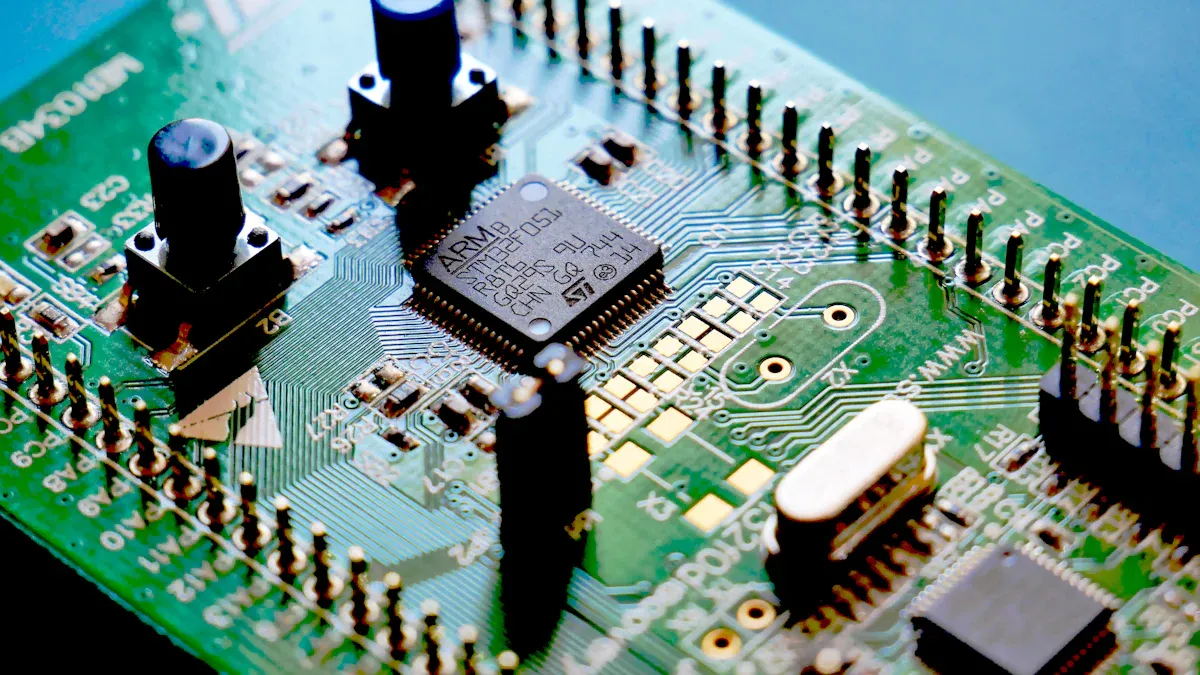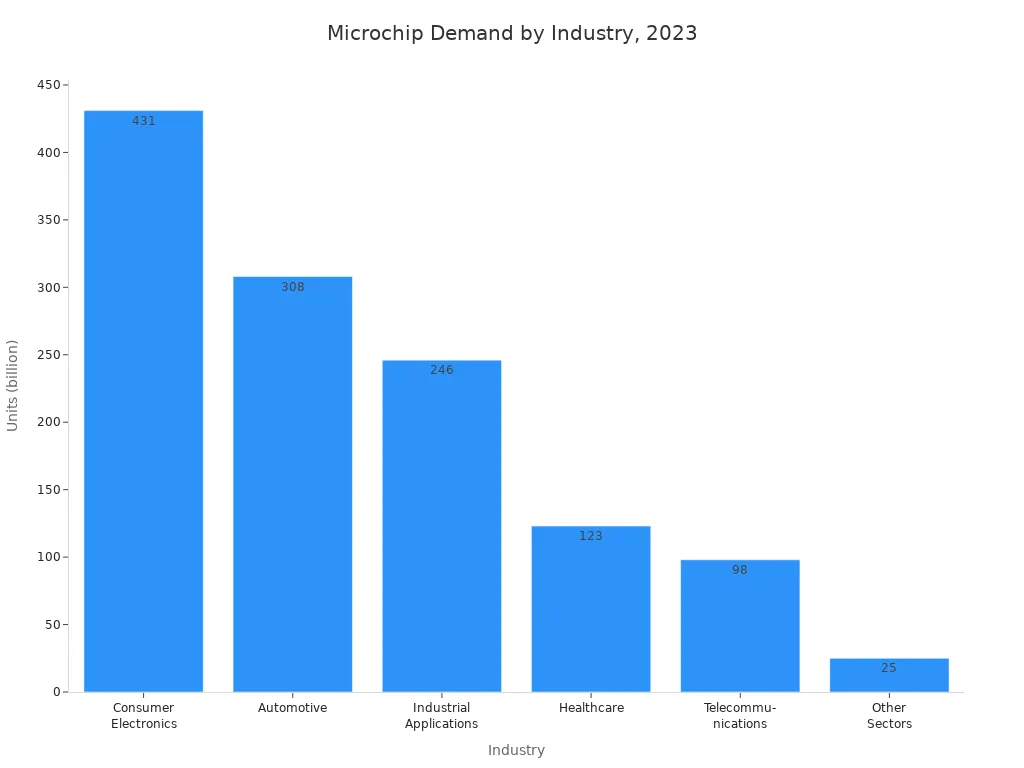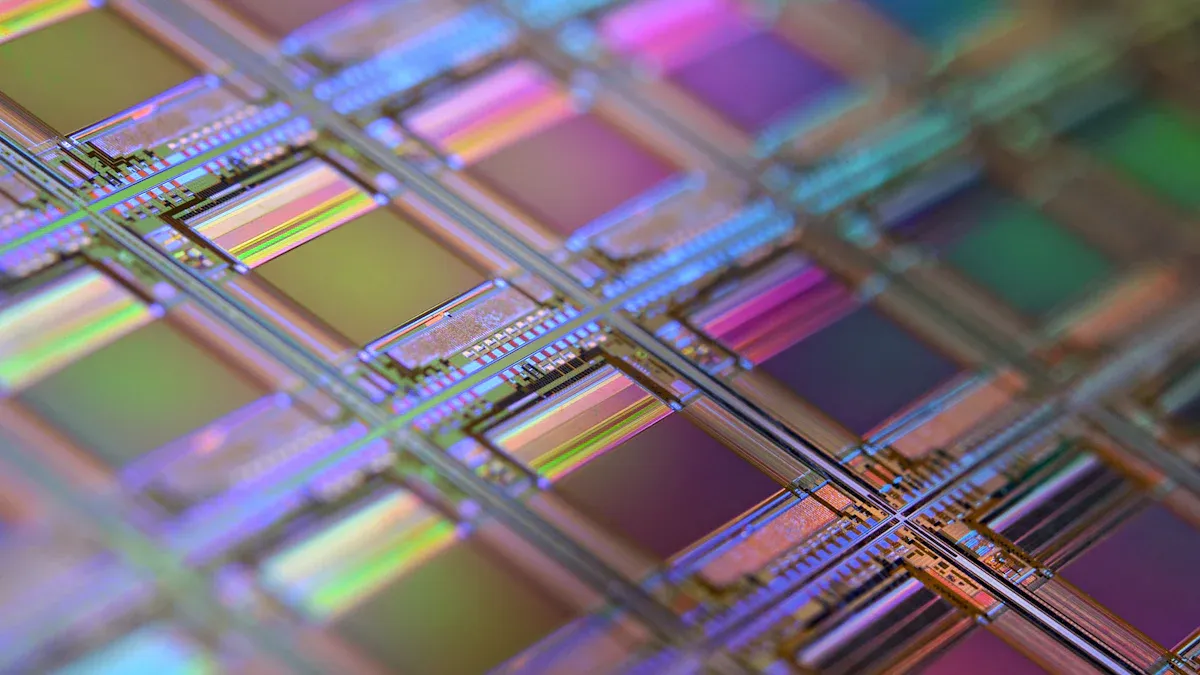What Is a Microchip and How Does It Work

A microchip, also called a chip or integrated circuit, acts like the brain of many modern devices. It manages information by turning electrical signals on and off, much like a series of tiny light switches. Microchips help smartphones answer calls, cars control engines, and even medical devices monitor health. The global microchip industry reached about USD 681 billion in 2024 and continues to grow quickly as more devices become smart and connected. Each year, factories produce over a trillion microchips for use in many fields.

Key Takeaways
Microchips are tiny silicon devices that control and process information in many modern gadgets.
They contain millions of parts like transistors that act as switches to turn electrical signals on and off.
Microchips power everyday devices such as smartphones, cars, medical tools, and smart home appliances.
Different types of microchips handle tasks like data storage, processing, sensing, and wireless communication.
Advances in microchip technology make devices faster, smaller, more energy-efficient, and smarter for the future.
What Are Microchips

Definition
A microchip is a tiny piece of technology that holds many electronic parts on a flat surface. People also call it an integrated circuit or chip. Microchips act as the control center for many electronic devices. They process information, store data, and help devices perform tasks quickly and accurately. Since their invention in the late 1950s, microchips have changed how people use technology. Early versions powered military and space equipment. Today, they appear in almost every modern device, from computers to cars.
Microchips have become smaller and more powerful over time, following a trend called Moore’s Law. This means the number of parts inside a chip doubles about every two years, making devices faster and smarter.
Structure
Microchips contain billions of tiny parts called transistors, along with resistors and capacitors. These parts work together to control and move electrical signals. The main material used to make microchips is silicon. Silicon comes from sand and has special properties that let it act as both a conductor and an insulator.
Key materials and components found in microchips:
Transistors (especially MOSFETs) act as switches, turning electrical signals on and off.
Resistors and capacitors help control and store electrical energy.
Metal pathways, made from aluminum or copper, connect all the parts.
The chip sits on a thin slice of silicon called a wafer.
Manufacturers build microchips layer by layer. They use special processes like photolithography, etching, and doping. Doping adds tiny amounts of other elements to the silicon, creating regions that help transistors work. Each transistor has three main parts: the source, the drain, and the channel. A gate sits above the channel. When voltage is applied to the gate, it lets current flow from the source to the drain, turning the transistor on.
Material | Why It’s Used |
|---|---|
Silicon | Abundant, good for making transistors |
Germanium | Used in special chips for solar cells and sensors |
Gallium arsenide | Handles heat and high frequencies well |
Indium phosphide | Used in lasers and photonic circuits |
Aluminum/Copper | Excellent for carrying electrical signals |
Purpose
Microchips serve many important roles in electronic devices. They process data, manage power, and control how devices work. In computers and phones, microchips act as the brain, running programs and storing information. In cars, they help control engines and safety systems. In medical devices, they monitor health and support life-saving functions.
Common uses for microchips include:
Running calculations and processing information in computers and smartphones
Storing data in memory chips
Managing power and battery life in portable devices
Controlling sensors and motors in robots and vehicles
Improving energy efficiency in home appliances
Microchips have made it possible for people to enjoy smart devices, safer cars, and better healthcare. They continue to shape the way people live, work, and communicate.
How Microchips Work
Binary Processing
Microchips use a special language called binary code. This language has only two symbols: 0 and 1. Each symbol stands for an electrical state. A "1" means the circuit is on, and a "0" means it is off. Transistors inside the chip act like tiny switches. They turn on and off very quickly to process information. When a person types on a computer or taps a phone, the device changes those actions into a series of 0s and 1s. The microchip reads these signals and decides what to do next.
Some microchips also handle analog signals. Analog signals are smooth and can have many values, like the sound from a microphone. The chip changes these signals into digital form so it can process them using binary code. Integrated circuits help manage both digital and analog signals, making devices smarter and more flexible.
Microchips process billions of binary signals every second, allowing devices to work fast and accurately.
Components
A microchip contains many small parts that work together. Each part has a special job. The table below shows the main components and what they do:
Component | Function Description |
|---|---|
Transistors | Act as tiny switches controlling electrical flow by turning electricity on or off. |
Resistors | Regulate the speed and amount of electrical current flowing through the circuit. |
Capacitors | Temporarily store electrical charge, aiding in short-term memory and information retention. |
Diodes | Ensure electricity flows in only one direction, preventing reverse current flow. |
Modern microchips often combine many functions into one chip. For example, a System-on-a-Chip (SoC) can include a CPU, memory, and wireless modules. This design saves space and makes devices more powerful. Some chips, called ASICs, are made for special jobs like running medical equipment or controlling cars.
Other important parts found in microchips include:
CPU (Central Processing Unit): Runs instructions and handles data.
Memory (RAM and ROM): Stores information for short or long periods.
Sensors: Collect data from the environment, like temperature or movement.
Wireless Communication Modules: Connect devices using Wi-Fi, Bluetooth, or 5G.
Power Management Circuits: Help save energy and extend battery life.
Manufacturing
Making a microchip is a complex process. It starts with pure silicon, which comes from sand. Factories slice silicon into thin wafers and polish them until they are very smooth. The steps below show how a microchip is made:
Wafer Preparation: Workers cut silicon ingots into thin wafers and polish them to remove any flaws.
Deposition: Machines add thin layers of materials to the wafer. These layers can conduct, insulate, or control electricity.
Photoresist Coating: The wafer gets a coating of photoresist, a material that reacts to light.
Lithography: Special lights shine through a pattern onto the wafer. This step creates the tiny shapes that form the chip’s circuits.
Etching: Chemicals remove unwanted material, leaving behind the circuit design.
Ion Implantation: Ions are shot into the wafer to change how it conducts electricity. This step helps create transistors.
Packaging: The wafer is cut into small chips. Each chip is placed in a protective case to keep it safe and cool.
Miniaturization has changed how microchips are made. Factories now use advanced tools to make features as small as a few nanometers wide. New methods, like 3D stacking, let engineers build chips with more layers, saving space and boosting speed. These changes allow microchips to fit inside tiny devices like smartwatches and hearing aids.
Making microchips uses a lot of water and energy. Factories must handle chemicals safely to protect workers and the environment. Companies work to recycle materials and lower pollution, but challenges remain.
Types of Microchips
Microchips come in several types, each designed for specific tasks. The table below shows the main categories and their functions:
Category | Function Description |
|---|---|
Logic Chips | Process information as the 'brain' of devices using digital binary signals. |
Memory Chips | Store data; volatile types hold data temporarily, non-volatile retain data without power. |
ASICs (Application-Specific Integrated Circuits) | Perform single-purpose, repetitive tasks like barcode scanning or bitcoin mining. |
SoCs (System-on-Chip) | Integrate multiple components (CPU, GPU, memory, etc.) on one chip for complex system functions. |
Microprocessors | Execute computing tasks; contain one or more CPUs for general processing. |
GPUs (Graphics Processing Units) | Specialized microprocessors for rendering graphics and accelerating parallel computations. |
Analog Chips | Process continuous signals such as sound, light, or temperature; used in sensors and power regulators. |
Mixed Circuit Semiconductors | Combine analog and digital functionalities, e.g., microcontrollers with analog-to-digital converters. |
Digital Microchips
Digital microchips use binary signals—0s and 1s—to process information. These chips contain millions or billions of tiny parts, such as transistors and resistors, packed onto a small piece of silicon. Digital microchips include microprocessors, memory chips, and digital signal processors. System-on-a-chip (SoC) designs combine logic and memory, making them common in smartphones and wearable devices. Application-specific integrated circuits (ASICs) handle special jobs in medical equipment or cars. People find digital microchips in computers, phones, network switches, home appliances, and even cars and airplanes.
Digital microchips allow devices to perform complex tasks quickly and reliably.
Analog and Mixed Signal Microchips
Analog microchips handle signals that change smoothly, like sound or temperature. These chips use traditional parts such as resistors and capacitors to process real-world information. Mixed-signal microchips combine analog and digital circuits on one chip. This design lets them work with both continuous and binary signals. Mixed-signal chips appear in smartphones, cars, medical monitors, and industrial machines. They help devices sense the world and then process that data digitally.
Mixed-signal microchips save space and improve reliability by reducing the need for extra parts.
RFID Microchips
RFID microchips use radio waves to identify and track objects. These chips come in three types: passive (no battery), active (battery-powered), and semi-passive (battery-powered but activated by a reader). RFID chips appear in home automation, contactless payment cards, access control systems, and inventory tracking. Stores use RFID to manage stock, while hospitals use it to track equipment and patients. RFID chips include security features like encryption and authentication to keep data safe.
Common uses for RFID microchips:
Access control for buildings and rooms
Inventory and asset management in stores and warehouses
Contactless payments and public transit cards
Healthcare for tracking patients and medicines
RFID technology increases convenience, security, and efficiency in daily life and industry.
Microchips in Daily Life

Common Devices
People see the results of microchip technology every day. Many devices at home, school, and work depend on these tiny circuits to function. Some of the most common examples include:
Smartphones use chips to power their processors, cameras, and wireless connections.
Laptops and computers rely on chips for running programs, storing files, and displaying images.
Televisions use chips for image processing and smart features.
Gaming consoles depend on chips for graphics and online play.
Wearable technology, such as fitness trackers and smartwatches, uses chips for health monitoring and notifications.
Modern appliances, like refrigerators and washing machines, use chips for smart controls and energy savings.
Tablets, routers, and modems all use chips for fast processing and communication.
Cars use chips for engine control, safety systems, and entertainment.
Even simple calculators use chips to solve math problems.
Microchips act as the brains of these devices. They combine processors, memory, sensors, and wireless modules to make devices smarter and more efficient.
Benefits
Microchips bring many advantages to both consumers and industries. Some key benefits include:
High durability and long lifespan, which means devices last longer.
Low power use, making them ideal for portable and battery-powered products.
Reliable performance and fast operation.
Flexible designs that allow for easy upgrades and new features.
Support for advanced technology, such as artificial intelligence and 5G networks.
Smaller size, which helps create compact and wearable devices.
Benefit | Description | Example Use |
|---|---|---|
Uses less power, saves battery life | Wearables, IoT devices | |
High Performance | Handles complex tasks quickly | Gaming, AI devices |
Flexibility | Adapts to new features and updates | Smartphones, tablets |
Reliability | Works well over long periods | Medical equipment |
Safety and Privacy
People often worry about the safety and privacy of chip-enabled devices. Some main concerns include hacking, data leaks, and misuse of personal information. Chips in phones and wearables can store sensitive data, such as health or location details. Hackers may try to access this data if devices lack strong security.
Privacy risks also come from how companies use and share data. Sometimes, chip data gets used for reasons beyond what users expect. Laws and rules about chip data use are still developing, so users should stay informed.
Pet owners sometimes believe that pet microchips can track their animal’s location. This is a myth. Pet chips do not have GPS. They are passive devices that only store a unique ID number. A vet or shelter must scan the chip to identify a lost pet. For real-time tracking, owners need a GPS collar.
Tip: Always use strong passwords and update device software to help protect personal data.
Future Trends
Innovation
The world of chip technology changes quickly. Engineers now use three-dimensional FinFET transistors instead of older flat designs. This new shape helps chips work better and use less energy. Another big step is backside power delivery, which separates power lines from signal lines. This change allows chips to become even smaller and more efficient. Companies like TSMC are working on chips as tiny as 1.6 nanometers. These advances mean devices can run faster and last longer on a single charge.
Many new solutions focus on artificial intelligence (AI) and data centers. For example:
High-speed cable designs make connections in data centers faster and easier.
Special Ethernet chips improve how fiber cables carry data, boosting bandwidth by up to 50%.
Power modules now fit into small spaces and use less energy.
Digital signal controllers add security and make power supplies more reliable.
New microprocessors help manage data centers safely and allow remote updates.
Other trends include stacking chips in layers to save space and boost performance. More companies design their own chips to control quality and avoid supply problems. Cloud-based design tools help teams work together from anywhere. AI and machine learning shape how chips are built and used, leading to smarter and more powerful devices.
Impact
Advances in chip technology touch many parts of life. In healthcare, better chips improve medical imaging, help control devices like pacemakers, and support new treatments such as gene therapy. Doctors use these chips in MRI machines, insulin pumps, and wearable health trackers.
Industry | Impact of Chip Advancements | Key Applications and Benefits |
|---|---|---|
Healthcare | Improves imaging, device control, and supports new treatments | MRI, pacemakers, drug discovery, wearables |
Enhances engine control, safety, and supports electric and self-driving cars | Engine management, emissions, lane assist, battery control, sensor data | |
Consumer Electronics | Powers portable devices with more features and better performance | Smartphones, laptops, gaming, smart home devices |
Society also feels the effects of these changes. People have mixed feelings about using chips in their bodies or at work. Some support the idea, while others worry about privacy and safety. Laws now protect workers from being forced to get chip implants. As chips help people work longer and smarter, rules about privacy and fairness may change. The way people accept and use this technology will shape its future.
Note: Energy efficiency and sustainability now guide chip design, especially for cloud computing and large data centers.
A microchip is a tiny electronic device made from silicon that contains millions of parts like transistors and resistors.
These chips replaced older, larger circuits, making devices smaller, faster, and more reliable.
Microchips power tools people use every day, from phones to medical devices, and help create smarter, more connected technology.
Staying informed about new chip developments helps everyone understand changes in technology and prepares them for a future filled with innovation.
FAQ
What is the main job of a microchip?
A microchip controls how a device works. It processes information, stores data, and helps the device follow instructions. People rely on microchips in phones, computers, cars, and many other tools.
Can a microchip track someone’s location?
No, a standard microchip cannot track location. For example, pet microchips only store an ID number. They do not have GPS or send signals. A scanner must read the chip to get information.
How small can microchips get?
Engineers now make microchips with features just a few nanometers wide. Some chips are smaller than a grain of rice. This small size lets them fit inside tiny devices like hearing aids and smartwatches.
Are microchips safe to use in the body?
Doctors use special microchips in medical devices. These chips must pass strict safety tests. They help monitor health or deliver medicine. Most people do not feel them once doctors place them inside the body.
See Also
Understanding MCU Microcontrollers And Their Operational Functions
Exploring Computer Chips And The Way They Function
How Real-Time Microcontroller ICs Operate And Perform Tasks
A Guide To Communication Chips And Their Working Principles
Understanding Programmable Logic Chips And Their Functionality
